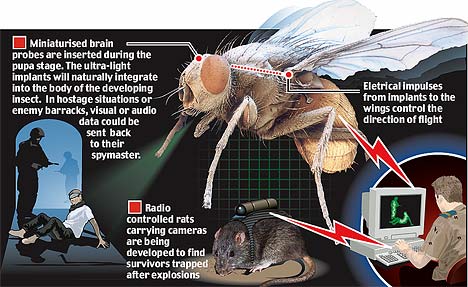Insects become fly-on-the-wall spies with tiny cameras, radio controls and microphonesBy FIONA MACRAEThe Daily Mail Mar. 14, 2008 |
Popular 
Report: Blinken Sitting On Staff Recommendations to Sanction Israeli Military Units Linked to Killings or Rapes

America Last: House Bill Provides $26B for Israel, $61B for Ukraine and Zero to Secure U.S. Border

Bari Weiss' Free Speech Martyr Uri Berliner Wants FBI and Police to Spy on Pro-Palestine Activists

'Woke' Google Fires 28 Employees Who Protested Gaza Genocide

John Hagee Cheers Israel-Iran Battle as 'Gog and Magog War,' Will Lobby Congress Not to Deescalate
  VIDEO: Watch the research footage of the locomation control of a moth in the labIt sounds like the stuff of science fiction - beetles, rats and sharks turned into cunning spies courtesy of a brain implant or two. VIDEO: Watch the research footage of the locomation control of a moth in the labIt sounds like the stuff of science fiction - beetles, rats and sharks turned into cunning spies courtesy of a brain implant or two.But such scenarios are fast moving from fantasy to fact, with laboratories around the world hatching a new breed of spy. Moths, beetles, rats, pigeons and sharks have been installed with electrodes, batteries and even video cameras in an attempt to create the ultimate spook. This week's New Scientist reports: "The next time a moth lands on your window sill, watch what you say. "It may look like an innocent visitor, irresistibly drawn to the light in your room, but it could actually be a spy - one of a new generation of cyborg insects with implants wired into their nerves to allow remote control of their movement. "Be warned, flesh-and-blood bugs may soon live up to their name." Such mechanised animals, or cyborgs, have many advantages over robots. Sharks, moths and rats, for example, have an amazing sense of smell that allows them to detect the faintest traces of chemicals. And if you can hide the controls within the creature's body, it would be virtually indistinguishable from any other animal - and so the perfect spy. Chief among the cyborg inventors is the U.S. military, with its research bureau ploughing money into projects from remote-controlled rats to battery-operated beetles. Trained to sniff out particular scents, such as human bodies or explosives, the rats' movements are controlled by electrodes implanted in their brains. Video camera backpacks transmit images of their mission back to the spymaster. Although the U.S. has stopped funding the rat research, the Israeli government is keen to use the creatures to search for survivors of explosions. While rats might be big enough to carry video cameras and other paraphernalia, their size makes it difficult for them to blend into the background. With this in mind, the U.S. Defense Advanced Research Projects Agency has switched its focus to insects such as moths and beetles. In an attempt to make the insects as inconspicuous as possible, miniaturised brain probes are inserted during the pupa stage. The idea is the ultra-light implants will naturally integrate into the body of the developing insect. DARPA's ultimate aim is to create cyborg insects that can fly more than 300 feet to their target and then stay put until commanded to buzz off again. Researchers have also succeeded in creating remote-controlled pigeons and sharks. New Scientist concludes: "If the groups keep making strides, the proverbial fly on the wall may literally become a spy." |



